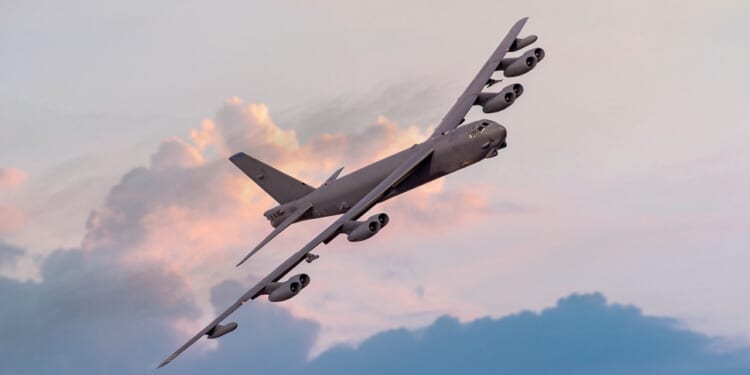The Air Force’s newer bombers were tailored for narrow mission sets that have aged poorly in the 21st century, while the B-52 Stratofortress remains extremely adaptable.
In an aerospace era of stealth and supersonic speed, the Boeing B-52 Stratofortress seems anachronistically out of place. Massive, slow, and glaring on radar, the B-52 is a throwback to the Eisenhower era, when it made its first flight.
Yet the B-52 refuses to die. Even as the bombers that were meant to replace the B-52, the supersonic Rockwell B-1B Lancer and the stealthy Northrop Grumman B-2 Spirit, are retiring, the B-52 marches on with new engines and new software, ready for another half-century of service.
The B-52 Stratofortress’ Specifications
- Year Introduced: 1955 (B-52 entered USAF service in February 1955)
- Number Built: 744 (all variants produced); 76 B-52H airframes remain in USAF service (approx.)
- Length: 159 ft 4 in (48.5 m)
- Wingspan: 185 ft 0 in (56.4 m)
- Weight:
- ~185,000 lb (84,000 kg) empty (approx.)
- ~488,000 lb (221,000 kg) max takeoff weight (approx.)
- Engine: Eight Pratt & Whitney TF33-P-3/103 turbofan engines (~17,000 lbf / ~76 kN thrust each); planned/announced re-engining programs (e.g., Rolls-Royce F130/BR700 family derivatives) for future service life extension
- Top Speed: ~650 mph (1,046 km/h); about Mach 0.86 at altitude (approx.)
- Combat Radius: Mission- and load-dependent; typical practical combat radii vary widely (roughly several thousand miles / ~3,000–7,000 km depending on payload, routing, and aerial refueling)
- Service Ceiling: ~50,000 ft (15,240 m); varies depending on loadout
- Loadout: ~70,000 lb (≈31,500 kg) of mixed ordnance
- Aircrew: 5 (pilot, co-pilot, weapon systems officer, navigator, electronic warfare officer); varies based on loadout / mission parameters
Why Is the B-52 Still Relevant Today?
The B-52 was never a glamorous platform. With enormous wings and long range, the B-52 could carry a heavy payload across oceans and loiter for hours. That fundamental truth has not changed in the seven decades the B-52 has been active. And that ability is still coveted, even in modern warfare, where the ability to deliver precision standoff weapons from safe distances matters more than sneaking through radar nets. Today, a B-52 loaded with long-range cruise missiles can strike targets thousands of miles away without ever crossing a hostile border. That’s invaluable in a world where anti-air defenses can see most everything, meaning that sometimes stealth isn’t what dictates survival, and rather, distance is.
The reason the B-1B and B-2 are being phased out while the older B-52 survives, is because the newer bombers were tailored for narrow mission sets that have aged poorly in the 21st century. Specifically, the B-1B provided low-altitude penetration, which has become redundant with the onset of GPS-guided munitions and long-range missiles that allow bombers to operate from higher, safer altitudes. The B-2, meanwhile, features stealth coating that requires a uniquely involved maintenance routine—resulting in a fragile airframe that costs an astonishing six figures per hour to operate. Both the B-1B and the B-2 were designed during the Cold War, to break through the Soviet radar network, but the defense grids that the two bombers were designed to penetrate have been constantly upgraded over the course of a generation, lowering any likelihood of survivability from an aircraft attempting to penetrate with either low-level high-speed or stealth.
The B-52 Is an Ideal Multipurpose Bomber
The B-52 has also aged much better than its peers from a logistical standpoint. The B-52’s systems are accessible, modular, and easily upgraded. The Air Force can simply bolt on new sensors, jammers, and targeting pods as technology evolves, keeping the B-52 up to date despite its ancient core structure. And now, with new Rolls Royce F130 engines, the B-52 will enjoy double range and efficiency, while new digital cockpits replace the analog gauges held over from the Kennedy era. That adaptability is a huge part of why the B-52 still flies.
Another part of the reason is the B-52’s relatively low cost. “Relatively” is key here: the B-52 costs about $70,000 per flight hour, which could not be considered cheap under normal circumstances. But it is a bargain relative to the B-2. And at that price, the Air Force can afford to maintain volume, which will be in demand as the US pivots towards Asia.
The B-52’s longevity is already legendary. But with another few decades of service scheduled, the B-52 may well go down as the most enduring platform in US aerospace history.
About the Author: Harrison Kass
Harrison Kass is a senior defense and national security writer at The National Interest. Kass is an attorney and former political candidate who joined the US Air Force as a pilot trainee before being medically discharged. He focuses on military strategy, aerospace, and global security affairs. He holds a JD from the University of Oregon and a master’s in Global Journalism and International Relations from NYU.
Image: Shutterstock / Christopher Chambers.

















